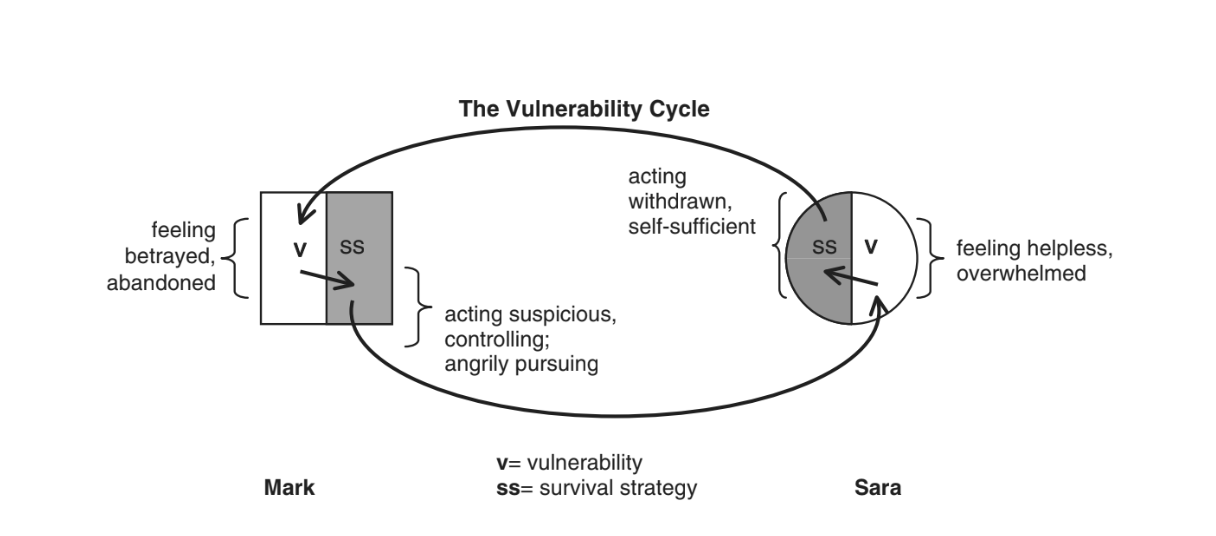Why Couples Fight: Understanding the Vulnerability Cycle
Written by MJ Falcon Gimenez, MHC-LP
Do you find yourself engaging in the same fight repeatedly with your partner? Do you feel stuck in polarized viewpoints unable to find common ground? Are you reactive and increasingly disconnected in your relationship? If the answer to any of these questions was yes, then you and your partner may benefit from exploring and understanding the cyclical pattern of your interactions in a couples therapy space.
While these cyclical fights may seem unbreakable, intimidating, and unresolvable at times, understanding two key components, in what we call your vulnerability cycle, can increase empathy, friendship, and guide you past this impasse.
The major two components of a vulnerability cycle are:
Vulnerability: A wound from a past life experience that leads us to carry a particular sensitivity in relational interactions. Typically experienced as threat, fear, longing, shame, humiliation, helplessness, powerlessness, jealousy, disrespect, etc.
Survival Strategies: The best way we may have found to gain control in situations where we have felt threatened. These may include feelings, beliefs, assumptions, and strategies that we adopt throughout our lives which offer protection.
When a vulnerability is triggered in a relationship, one partner typically perceives a threat and anticipates hurt. This activates the couples automatic reaction, survival strategy, in order to protect themselves much like situations in the past. In some cases, one partner's survival strategy may trigger the other, leading to mutual activation and a cyclical conflict. It is important to note that survival strategies do not purely develop in childhood. They may be developed due to past romantic relationships, adolescence or early adulthood experiences, or a wound developed in their present romantic relationship.
Take Mark and Sara’s relationship for example:
When Sara, who grew up in a family that valued self sufficiency over emotional dependence, began attending graduate school, Mark became overwhelmed with feelings of jealousy and anger. Mark’s survival strategies included various forms of attention seeking behavior to decrease the level of abandonment he felt. These behaviors presented as incessant calling, angry voicemails, and infidelity allegations. This survival skill was developed through years attempting to gain his depressed mothers attention and love. To Sara, who was used to withdrawing and processing her emotions independently, these strategies resulted in feelings of helplessness and overwhelm. Which in turn led her to withdraw, further exacerbating Mark's feelings of abandonment, which continued the cycle.
[This is a diagram representing the above dynamic]
By engaging in couples therapy, Sara and Mark were able to understand the origins of each other's survival strategies, and in turn increase empathy and connection. Mark was able to regulate his emotions prior to calling Sara which decreased her feelings of overwhelm. Sara created intentional time together despite her busy schedule to help decrease Mark's feelings of abandonment. Gaining awareness of the triggers in your relationship, whether yours or your partners, can help bring a sense of compassion and deeper understanding of each other. This can open the door to discussing things that either of you are yearning for in the relationship.
A vulnerability cycle is like a pre choreographed dance, which overtime may become entrenched in the couples dynamic. Usually, this dance takes one of four directions. Couples can experience conflict, pursuing/distancing, mutual withdrawal, or infidelity. A conflictual dynamic may present in quickly escalating fights, verbal matches, and volatile behavior. While pursuing/ distancing dynamics may lead to one partner withdrawing while the other insists for more, think of Mark and Sara. Mutual withdrawal creates distance as both partners choose to avoid conflict and may be simply co-existing. When looking at cases of infidelity, the couple typically switches off dances prior to seeking unmet needs elsewhere, sometimes this can be an attempt at keeping the current relationship together by supplementing their needs with an outside party. While all of these effects may seem drastically different, the way forward is the same: understand each other's wounds and survival strategies and develop ways to recognize and respond in a way that fosters intimacy.
So where do you start?
Navigating this work without an unbiased professional can be challenging, so couples therapy is typically recommended in these scenarios. Here at LEL Therapy, we offer pre-marital, couples, and marriage counseling in a conveniently virtual setting for couples residing in NYC and New York State. Just fill out the inquiry form below to schedule a 15 minute consultation call with our couples therapist.
You don’t have to do it alone!
Reach out for a free 15 minute consultation today!
References:
Scheinkman, M., & DeKoven Fishbane, M. (2004). The vulnerability cycle: Working with impasses in couple therapy. Family Process, 43(3), 279-299.


